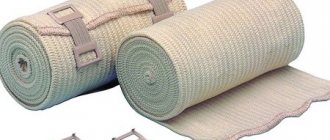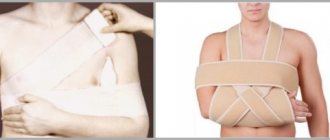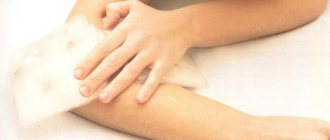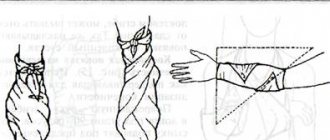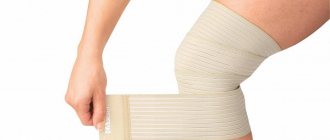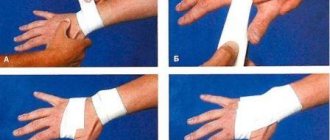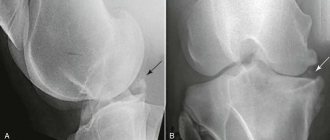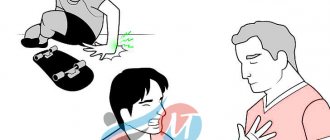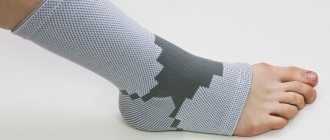Polymer gypsum is the most high-tech product used in the field of traumatology. Thanks to its unique properties, plaster provides maximum wearing comfort. We can talk for a long time about the disadvantages of standard plaster: it is heavy, uncomfortable, rubs, and interferes with everyday life. As a result, the patient’s movements are constrained not only in the damaged area, but due to the uncomfortable cast, he requires constant assistance.
A sling is a classic and effective way to immobilize an injured limb. For fractures, plaster is most often used - it fixes the limb in a given position for the entire duration of treatment. Its disadvantages include the fact that when applying it, it is necessary to correctly determine the tightness of the fit to the limb - after all, it will be difficult to change it. And during healing, swelling may appear and subside - which means the fit will not be perfect.
At the moment, plastic plaster is considered the most convenient alternative. Such a bandage, applied by a doctor, will securely fix the limb without causing inconvenience or limiting movements beyond what is necessary.
What it is?
Polymer gypsum is not gypsum at all. This is a plastic bandage that is placed on the arm or leg for fixation. Such an orthopedic product often looks like polymer bandages. Despite the small thickness and light weight, the bandage is durable.
The use of a circular plastic bandage is recommended for closed limb fractures. Other types of polymer cast can be used to heal a wide variety of fractures: ankles, fingers. They will also help with injuries to the shoulder, foot, and hand. The main benefit from a medical point of view is the preservation of flexibility - this is especially important for restoring function of the injured limb.
Application of a large circular plastic bandage - 4,000 rubles.
Application of a small circular plastic bandage - 3,000 rubles.
Removing a circular plastic bandage - RUB 3,000.
15 - 20 minutes
(duration of procedure)
outpatient
How a figure-of-eight bandage is applied to different parts of the body
The peculiarity of the figure-of-eight bandage is that it can be applied both to a massive part of the body, such as the chest, and to a small part, such as the eye. In the first case, bandaging begins with securing movements in the lower part. The bandage is then moved across the right side from the back to the top of the left shoulder girdle. The dressing material is lowered down to make a similar turn around the chest. It is fixed in a circular motion around the chest, securing it with a pin.
Application to the eye also begins with fixing it in the area of the eyebrow. The bandage is drawn towards the back of the head and passed directly above the ear, and then slowly rises to the top of the head and closes the injured eye. Then it moves towards the back of the head.
Features of the material
There are four types of bandages: adhesive cast, softcast, primecast and turbocast. They differ in material and are selected individually, depending on the specific clinical situation.
The most commonly used bandage is adhesive tape. This variety is lightweight; weight can be minimized due to a special breathable material - this ensures a constant supply of air to the skin. Applying a bandage is simple, no special equipment is required, but it must be performed by a specialist with medical education. Scotchcast's combination of ease of application and convenience makes it a popular choice.
The main disadvantage is the need to use a lining. It is recommended to purchase a cotton stocking and wear it under the cast. Can be used in combination with softcast - wrap a bandage around it to ensure water resistance.
The bandage is made of hypoallergenic material. Another advantage is that the structure of the material allows for faster removal of swelling. The structure of the material ensures excellent gas exchange.
Scotchkast is a universal bandage; application is possible for almost any fracture and even for sprains and cracks. Main advantages: air exchange, the ability to take x-rays without removing the cast, the ability to use a limb, can be used for children.
Indications
- Closed fractures.
- Recovery after repositions and operations on bone tissue.
- Stretches.
- Cracks.
- Bruises requiring temporary fixation.
Contraindications
- The presence of an open wound in the fracture area.
How to choose an elastic ankle bandage?
To fix the ankle and foot, use an elastic or compression bandage with a high degree of extensibility. This bandage can stretch 150% relative to its own length.
A tighter bandage (low or medium stretch) when bandaging the foot reduces the mobility of the joint and, instead of coping with swelling, increases it.
To bandage the ankle, use an Intex bandage 1.5-2 m long and 8-10 cm wide. An elastic bandage is used for primary injury and to strengthen the ankle after a dislocation or healing of a fracture.
Advantages and disadvantages
The main advantages of using polymer gypsum for fractures:
- The ability to ensure normal air exchange is extremely important during long-term healing of complex fractures. The skin will not suffer from a lack of oxygen.
- Better fit means better fixation and faster healing of the fracture.
- Due to the correct fit, the likelihood of swelling due to compression is reduced.
- The ability to perform household chores independently - take a shower, cook. The bandage reliably fixes the injured limb, eliminating the load on the fracture site. But the rest of the arm or leg retains full mobility and functionality.
- Maintaining limb flexibility is necessary for rapid rehabilitation. The ability to use a limb normally returns faster.
- Ease. The bandage is practically invisible, does not require support, and does not cause strain on the limb.
Plastic plaster can be applied to an arm, leg, or any other injured area.
Minuses:
- If the bandage begins to chafe or squeeze, it cannot be cut and will have to be completely changed.
- The cost is higher than a standard plaster cast.
Despite some disadvantages, plastic dressings are rapidly gaining popularity.
What are they used for?
Orthoses fix the joint, reduce the load on it and limit its movement. This is an analogue of a plaster cast, only it is worn with greater comfort. As a result, pain is reduced, bones, ligaments and muscles are in an anatomically correct position, which reduces the risk of progression of the pathological process.
Ankle orthoses made of low-temperature thermoplastic with shape memory are used for:
- Fractures of the inner or outer ankle, lower third of the leg bones;
- Damage to the ligaments and tendons of the ankle joint;
- Fractures of the bones of the foot (talus, calcaneus, tarsal and metatarsal bones);
- Conservative treatment of ankle ligament ruptures;
- Flaccid paralysis of the foot (as a foot holder);
- Stages of decompensation after reconstructive operations on the bones and ligaments of the ankle.
The orthosis performs the role of a plaster, but is lightweight and easy to use.
Reviews of doctors providing the service - Application of a circular plastic bandage
Several months ago, Igor Grigorievich performed arthroscopic surgery on my acromioclavicular ligament.
Installed dogbone implant. Everything is great, I lead an active lifestyle and play sports. I already forgot which side it was from! Read full review Alexey
25.11.2019
Dear employees, dear management of the Endosurgery and Lithotripsy Center, good afternoon! 2 months ago I had hip replacement surgery performed by specialists from the Center: Vladimir Sergeevich Zubikov - orthopedic traumatologist, doctor of medical sciences, doctor of the highest category, ... Read full review
Pershin Vladimir Alekseevich
20.08.2018
How long to wear an ankle brace
Wearing time depends on the diagnosis and can range from several hours a day to around-the-clock use. The wearing mode of the orthosis is determined by the doctor! In accordance with the recommendations of a specialist, the load is gradually increased. If the injury is severe, the time spent wearing the orthosis increases. It is recommended to maintain hygiene and remove the orthosis several times a day to treat with an antiseptic.
The joint should be loaded gradually - it must get used to physical activity. Some devices have laces, clasps and straps that loosen as they are repaired. This increases mobility, restores blood circulation, and strengthens muscles. The duration of therapy depends on the pathology and can last from a week to several months.
A correctly selected ankle orthosis will provide the required degree of support and make the recovery process correct and quick. If the orthosis is chosen incorrectly, not only will the recovery process be delayed, but there is also a risk of re-injury. You can independently choose only light fixation orthoses, which are used to prevent injuries, for arthrosis and arthritis.
ORTHOPEDIST-TRAUMOTOLOGIST
Technique and rules of application
The cross-shaped, or figure-of-eight, bandage is secured with circular rounds, then the bandage is crossed several times, forming a figure of eight. This bandage completely immobilizes the distal part of the upper limb, eliminating movement in the damaged joint. This speeds up the restoration of its functions and prevents re-injury. The bandage is applied in cross rounds; the principles of bandaging in this way are the same for different parts of the body. To apply a cross-shaped bandage to the wrist joint, you need to prepare a standard bandage, a sterile napkin, scissors, and tweezers.
Algorithm for applying a bandage:
- The skin in the joint area is treated with an antiseptic solution.
- The napkin is applied to the damaged area.
- A comfortable position for the hand is created.
- The first two fixing girths are made.
- Using a circular motion, the bandage is applied around the wrist towards the back.
- Each round overlaps the previous one by half the width of the bandage.
- A half-turn is made in the palm area, then the bandage is pulled out towards the elbow.
- One move is crossed.
- Repeated bandaging is carried out in an upward direction.
- The bandage is secured with a pin.
Note! Bandaging should not compress the tissue. If, after applying a bandage, the patient complains of pain, discomfort, numbness in the joint and hand, or paleness of the limb, the bandage must be reapplied, following all the rules.
In what cases is it used?
Fixation is necessary to provide first aid for various hand injuries. Bandaging is carried out to immobilize and speed up recovery. The bandage is necessary for skin injuries to prevent inflammation, apply the drug at home when receiving a minor injury or wound.
Indications for fixation:
- limb protection for open fractures;
- pain syndrome due to diseases and muscle damage;
- sports injury;
- inflammatory process in the joint area.
Before applying a bandage to fix the wrist joint, be sure to treat the damaged area with an alcohol-containing product. When there is a wound, an antiseptic wipe must be applied. It can be moistened in a solution of hydrogen peroxide, potassium permanganate, or applied with antibacterial ointment.
You can wear the bandage throughout the day; it does not interfere with your daily activities.
Why choose an ankle orthosis made of low-temperature plastic
Doctors love this material for its ease of use. With the same gypsum there is twice as much fuss, but its effectiveness is lower.
Advantages of ankle foot orthoses made of low-temperature plastic:
- the form is fixed in less than 10 minutes;
- lightweight material is comfortable to wear;
- suitable for athletes;
- allow the patient to take a bath, shower and other water procedures;
- hypoallergenic material does not irritate the skin and does not cause itching even when wearing the product for a long time;
- does not need to be removed during an x-ray examination (the structure is not visible on an x-ray);
- We create orthoses in different colors, which children really like;
- affordable price.
To order an ankle orthosis made of high-quality low-temperature plastic in our store, place an order on the website or by calling 8 800 500 8333.
The article was checked by Strakhov Maxim Alekseevich - Candidate of Medical Sciences, Associate Professor of the Department of Traumatology-Orthopedics and Military Field Surgery of the Federal State Autonomous Educational Institution of Higher Education Russian National Research Medical University named after. N.I. Pirogov of the Ministry of Health of Russia, Associate Professor of the Department of Traumatology and Orthopedics of the Federal State Budgetary Institution Federal Scientific and Clinical Center of the Federal Medical and Biological Agency of Russia (Moscow).
